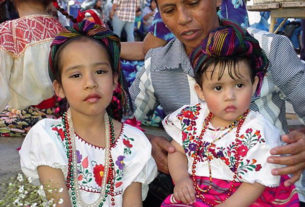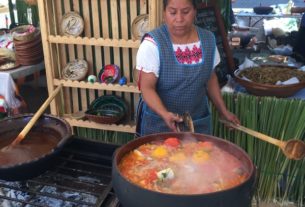Mexican History
The Maya, Aztecs, and other peoples of ancient Mexico had a very strong sense of their own history, which they went to great lengths to preserve. But in some ways, their concept of history differed radically from that of the invading Spaniards and later historians who wrote the history of Mexico from the European viewpoint. If we wish to understand the Mesoamerican concept of history, we must set aside many of our cultural preconceptions of what history should be and try to think our way back into the historical consciousness of the native peoples themselves.
Language is one of the main keys to understanding another culture. Ideally one would study the primary sources of Mesoamerican history in the original languages, Nahuatl, Maya, Mixtec, etc., whenever possible. The sheer effort involved in learning an Amerindian language with a completely different linguistic structure from English and other Indo-European languages would in itself help to restructure one’s thought patterns. This would allow the researcher a deeper insight into the target culture. However, we do have enough accessible primary source materials to allow us to reconstruct, at least to some extent, the pre-Hispanic view of history.
The Mesoamerican historical record includes pre-Hispanic and Colonial codices, non-codical sources, such as inscriptions on stone monuments and ceramics, post-Conquest and Colonial written texts, including written sources in the native historical tradition. Only a handful of pre-Hispanic codices escaped the holocaust of the Spanish Conquest, and these are mostly from the Oaxaca area. However, hundreds of native and mixed-style codices and manuscripts were produced during the Colonial Period and even into modern times. Many of these documents are based on pre-existing hieroglyphic manuscripts, and so provide a vital key to the form and content of the painted historical and religious books of Mesoamerica.
Pictorial or hieroglyphic manuscripts, sometimes amplified by written text, from the Valley of Mexico and the Oaxaca area are an especially important source of information on the native view of history. In Yucatan only four Maya codices survived the fiery wrath of Bishop Landa and his ilk, but they are mainly calendrical-ritualistic in content rather than historical. Undoubtedly many native historical documents were lost. From central Mexico only a couple of pre-Hispanic Aztec codices have survived. However, many Colonial codices in the Aztec or mixed Mixtec-Aztec style of the Borgia Codex, a major source for Mesoamerican religion, are also pre-Hispanic in content. From northern and western Oaxaca we have at least eight historical-genealogical codices in the pre-Hispanic style that give detailed accounts of Mixtec kings and queens and the deeds of famous warriors and rulers.
The term codex is something of a misnomer but it has become standard usage. Strictly speaking, a codex is a book or manuscript in European-style format. The typical Mesoamerican painted book is a screenfold of skin or bark paper (amate) covered with a thin coat of lime and then painted with pictographs, glyphic signs, etc. Folded, it looked like a book, spread out it was a long scroll-like affair. Some codices, such as the Codex Mendoza, were in typical book format and therefore are true codices. The contents of these documents include government, history, calendrical systems, religious beliefs, and cosmological views. However, in order to understand and interpret these documents we must take into account two very different points of view: the western or European historical tradition and the Mesoamerican concept of history.
History as we know it begins with the ancient Greek historians Herodotus, the so-called “Father of History,” and Thucydides, who was perhaps the more critical of the two. On this view, the critical approach to historical events and personages developed only in the west and spread outward from there. Unfortunately, this highly ethnocentric view of history fails to take into account the Mesoamerican concept of history and many others outside of the European world. If we follow this line of argument, the history of ancient Mexico as told by the Maya, Aztecs, and other indigenous peoples of the Americas is reduced to little more than a smattering of historical “truth” buried deep in a morass of myths, legends, and superstitions. At best “native” history can only be described as semi- or quasi- history, not real history in the Greek or western European sense. It was this misguided sense of superiority on the part of the Spaniards, as well as their quest for gold and Indian souls, that led to the horrors of the Spanish Conquest and its equally destructive aftermath.
The main differences between western European historiography and the Mesoamerican concept of history can be illustrated from two key terms: tradition and annals. At first glance the Nahuatl terms Itoloca (“That which is said about someone or something”) and Xiuhámatl (“Book of the Years”) appear to be similar in meaning, but it would be a mistake to equate the two. In Aztec thought Itoloca signifies “tradition.” From the western or European point of view, “tradition” is usually regarded as the (presumably) uncritical desire to preserve memories of notable past events and famous personages without too much regard for historical accuracy. The term annals, on the other hand, implies a written history based on a supposedly more critical approach to history than that of the Maya or the Aztecs. In the Mesoamerican context, however, these terms take on quite a different meaning based on a different concept of time and space.
Let us consider the meaning of the term tradition. Oral tradition in which writing plays little or no part is generally considered to be much less accurate than the written or literary tradition. This is not necessarily so. Early Celtic bards and tradition-bearers relied heavily on memory and yet managed to hand down through generations fairly accurate “texts” of Celtic history and lore. In ancient India the sacred Rigveda was transmitted verbatim long before it was ever written down. On the other hand many textual errors creep into written texts through the carelessness of scribes or the accident of time and circumstance, as a glance at the often numerous variant reading of any classical Greek or Latin text will confirm.
Several stages are involved in the development of historical writing, although not necessarily in strict chronological sequence. In a sense history actually begins with oral tradition. In the Iliad of Homer, Achilles sits in his tent singing of the “famous deeds of men,” while the battle for Troy rages on. Orally composed and transmitted epic poems and sagas often contain vivid recollections of historical events, although they may be amplified and cloaked in the formulaic language of epic poetry. Eventually, however, the oral tradition passes into some form of writing. In the written or literary tradition, annals consist of a series of dated but otherwise disconnected events, albeit in strict chronological order. Chronicles go one step further and present a consecutive historical account in a sustained narrative or story format.
In Mesoamerica, the transition from oral to written tradition took place in three stages, with local variations: (a) calendrical entries with illustrations in pictorial or hieroglyphic form; (b) a combination of prose and pictorial representations; (c) prose texts based in part on pre-existing pictorial-hieroglyphic manuscripts but eventually written from the outset.
These stages can be illustrated from the Aztec tradition. First, the oral tradition ( Itoloca) is an account, backed up by the codices, of what has happened to someone, i.e. a history. So too in the Indo-European tradition the epic Mahabharata of ancient India is described as itih_sa (“so indeed it was”), which in Sanskrit signifies a traditional account of events or a heroic history. Secondly, Xiuh_matl is a registry of the years in which are recorded notable events that occurred in those years. Chroniclers commonly translate this term as “annals.” Thirdly, Tlatolli (“word or discourse”) refers to the content of the historical narrative, the word or discourse that preserves the memory of the past. This is the final stage of historical writing in which a series of chronological events are put together in a running narrative to present the reader with a coherent story line.
We have very few pre-Hispanic codices or manuscripts but this does not lessen the value of documents produced after the Spanish Conquest. Even late records of Colonial history, such as genealogies, maps, economic accounts, and land records all contribute to the reconstruction of the history of Mexico as seen through the eyes of the people who lived it. For example, the 16th century post-Conquest Codex Boturini ( “Tira de la Peregrinación”) is a typical native screenfold of amate paper. This important pictorial manuscript covers the period from about A.D. 1168 to 1355; it tells the story of the migration of the Tenochca-Mexica from Aztlan, their arrival at Chapultepec, their subjugation to Coxcox, ruler of Culhuacan, and their final destination of Mexico-Tenochtitlan. While this codex is in a native or slightly acculturated style, the broken tree motif, for example, is said to show definite European influence.
In summary, primary source materials for the reconstruction of the Mesoamerican concept of history may be divided as follows: pre-Conquest Codices, documents produced under Spanish Patronage, Native Colonial pictorial manuscripts, and Mixed Colonial pictorial and written documents. Because of their pre-Hispanic content, some works by the early Dominican and Franciscan friars, such as Durán and Sahagún, must also be considered primary sources.



